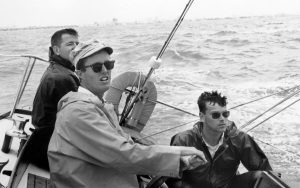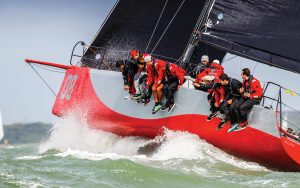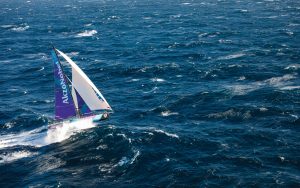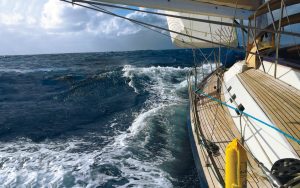In 1965 a young American designer, Dick Carter, met up with Bernard Hayman of Yachting World in the cockpit of Dick’s new race boat Rabbit. Yachting World recognised a mould-breaking…
How to buy Yachting World from home
Print issues You can order Yachting World print issues delivered to your door using Magazines Direct. There are subscription offers that include delivery from as little as £18.49 for six…
The inside story of the nail-bitingly close 2019 Sydney-Hobart race
Had any of the crew of the nine yachts that finished the inaugural Sydney Hobart Yacht Race in 1945 been able to comment on the race’s 75th edition, the phrase…
Expert sailing tips: Mike Broughton on racing fast and wet boats
There’s spray everywhere and your eyes are stinging. You are planing downwind in 20 knots of wind averaging 18 knots of boat speed and just as you are piling into…
Saffier SE27 Leisure: This beautiful daysailer is something special for the weekend
The Saffier SE27 Leisure builds on a long legacy that includes 160 SE26s delivered over the past decade. And it combines it with the modern styling of the Saffier SE37…
Southern Wind Shipyard embraces the rise of the super-cat
The naval architecture is by Berret Racoupeau, the La Rochelle firm behind Royal Huisman’s latest 35m/118ft sailing and power catamaran concepts. The multihull market is the fastest growing marine sector,…
Wildlife photography: Rick Tomlinson shares his top tips after Falklands expedition
“Orca – port bow!” The cry came from the pilothouse. A sense of excitement swept through the boat as 24 hours earlier we’d taken the decision to sail overnight from…
Family sailing: America’s Cup sailor turned cruiser explains his big change
“Morning Daddy!”“Hey, morning Hazza. Did you have a good sleep?” It’s dawn, I’m finishing the graveyard watch and the kids are just waking up. The sun is rising as we…
Volvo Ocean Race skipper explains when to back off in big conditions
To win, first you have to finish. Chris Nicholson needs no introduction to that old chestnut, having found himself in numerous hazardous situations in different parts of the world’s fierce…
Round-the-world sailors race for landfall as South Pacific begins coronavirus lockdown
Pushing off from the Galapagos Islands 3 weeks ago, the coronavirus was only starting to affect Europe. The first villages were being quarantined in Italy, and a handful of cases…
Mediterranean sailing: Lessons learned from 2 years exploring Europe’s great sea
With plenty of airports located along the most common cruising routes and cheap flights within Europe, keeping a yacht in the Med is easy and convenient. But what do cruisers…
Moody 41DS yacht tour: This comfortable cruiser is bigger on the inside
The 41DS is the smallest boat in Hanse Group’s Moody range, which also includes 45ft and 54ft deck saloon designs with living areas arranged around a single level ‘monomaran’ style…
Flyer: The inside story of this Whitbread winner’s amazing restoration
Flyer is one of those yachts that needs little introduction. Designed for the 1977 Whitbread Race by Sparkman & Stephens for Dutch skipper Conny Van Rietschoten, the 68ft aluminium ketch…
Sailing Fiji to New Zealand: The ultimate tradewinds test?
We who write for the yachting press are deluged with tales of extraordinary achievement. Although I’ve done more than my own share of ocean walloping, I’m often humbled by the…
iPad sailing: Pip Hare’s top tips on using your tablet to navigate
These days it’s rare for me not to use a tablet as part of my navigation equipment. The fact I can take my tablet with me anywhere in the world…
Road to the America’s Cup podcast: Why analytics matter now more than ever
Ten years ago Brad Pitt’s movie Moneyball sparked an explosion of interest in sporting statistics, an interest that is now reflected everywhere from fantasy football leagues to the NFL. The…
2019-20 Clipper Race postponed by 10 months due to Coronavirus outbreak
The 2019-20 Clipper Race is the latest major sporting event to be postponed as a result of the Coronavirus pandemic. The decision was announced on Monday (March 16) after crews…
Sailing Panama: Exploring idyllic islands just miles from the famous canal
We looked out at the expectant faces before us: kids with footballs in hand, an elderly woman yelling at the teenage boys to turn down their reggaetón music, and two…
Hallberg-Rassy HR40C: See inside the Swedish yard’s “best ever” build
The latest Hallberg-Rassys combine markedly more space with a newer-generation hull shape and twin rudders, yet still retain the brand’s hallmark style and attributes. This centre-cockpit model has a genuine…
Is your yacht oceanproof? How to prepare your boat for (nearly) anything
Well-prepared boats have dealt with half the battle when it comes to emergencies and challenges at sea. But beyond the boat and equipment, the mindset, experience and knowledge of skipper…























